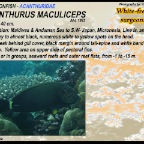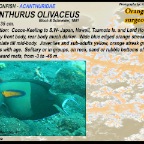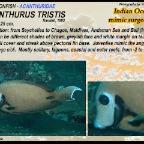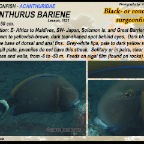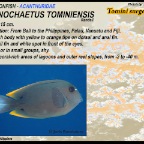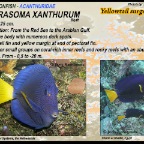Surgeonfish - Acanthuridae
SURGEONFISH - ACANTHURIDAE
The Acanthuridae family is divided into three sub-family. The scalpel surgeonfish (Acanthurinae) which has only one pair of scalpels on the tail-base, the unicornfish (Nasinae) who has two pairs of scalpels and the sawfish (Prionurinae) which has three to six pairs of scalpels at the tail-base. Surgeonfish are very common in the shallow waters of lagoons and on outer reefs. They have thin oval bodies with long continious dorsal and anal fins. They constantly cruise over the reef to feed on algae during the day, which they scrape off dead corals or rocks. They also will eat small crustaceans and worms will be digested with pleasure. The genus Ctenochaetus are the only ones in the family who feed on detritus. Unicornfish are plankton feeders and find their food in open water. Acanthuridae are very territorial and protect their areas from competition, both solitary or those in a group. When defending themselves or their territory, they bend their tail fin eighty degrees so the scalpels on their tail base protrudes further. These sharp knifes will even be used when there is trouble in the family. Surgeonfish are slow swimmers because they only use their pectoral fins to swim and the tail fin for steering, that's why they make up and down movements when swimming. Finding out the sex of the surgeonfish is very hard underwater. There are as good as no differences between the males and females. Only during mating season do some of the males change color. The unicornfish make it easier to identify because the males swim around with a bigger nose than the females. Reproduction happens during winter or spring time but depends on the position of the moon. Mating happens in pairs or in groups. They swim side by side towards the surface and on a certain moment they both change direction in a u-shaped curve while spawning. The fertilized eggs than will be transported to open sea by the current. Because the larvae stage takes a long time, surgeonfish are well spread out and can be found in all tropical seas. Length: 25 cm.Distribution: from the Red Sea to the Arabian Gulf.Dark blue body with numerous dark spots. Yellow tail fin and yellow margin at end of pectoral fin.In pairs or small groups on coral-rich inner reefs and rocky reefs with an abundanceof algae. From - 0,5 to -20 m. Length: 40 cm.Distribution: Indonesia to SW- Japan, Hawaii, Fr. Polynesia, G.B.R. and New Caledonia;Similar to Z. desjardinii but has no spots on the tailfin. The tailfin is white-yellow tobrown, large grey to brown dorsal and anal fins with fine blueish lines. Juveniles are bright yellow with alternating dark and light vertical bands. Solitary or in small groups.In lagoon or on outer reefs to -45 m. Length: 22 cm.Distribution: from S- Africa to Madagascar and Mauritius.Dark brown body with numerous small white spots which continue on the largedorsal and anal fins. Yellow tail and pectoral fins. Very territorial.Juveniles in shallow water, adults mostly around -20 m.On coral- and rocky reefs, from -10 to -60 m. Length: 20 cm.Distribution: S.W- Japan to Hawaii, Mariana Is, Marshall Is, Wake Is. and Marcus Is.Very easy to distinguish because of the complete yellow body and fins.White tail spine, occasionally white horizontal line along the middle of the body.Solitary or in loose groups among coral-rich areas in lagoons and outer reef slopes. From -2 to -46 m. Feeds on algae. Length: 40 cm.Distribution: from the Red Sea and E- Africa to the Andaman Sea and N- Sumatra.Similar to Z. veliferum but has spots on the tailfin. Dark tail fin with lighter blue spots.Large grey to brown dorsal and anal fins with fine yellow to green lines. Juveniles are similar but yellow from colour . Solitary or in small groups.In lagoons or on outer reefs, from -3 to -30 m. Length: 31 cm.Distribution: E- Africa to SW- Japan, Micronesia, Line Is, New Caledonia and G.B.R.Blueish body colour with a big black mark on the side and back, going from the eyesto the tail base. Yellow tail fin with black border, black marginal band on arse- and dorsal fin. Solitary or in loose aggregations, feeds on zooplankton. On clear current swept outer reefs, from -2 to -40 m. Length: 50 cm.Distribution: E- Africa to SW- Japan, Micronesia, Polynesia, New Caledonia and G.B.R.Blue-grey to brown body with brown head. Blue spots and vertical lines on the sides,blue lips and blue band going over the nose from eye to eye. Is able to change the blue colour and pattern rapidly. Tail fin with yellow to orange margin and two blueextensions. In schools near reef slopes, common around wrecks. From -4 to -50 m. Length: 70 cm.Distribution: Red Sea and E- Africa to SW- Japan, Hawaii, G.B.R.and Lord Howe.Grey to olive-green with paler belly, blue tail-spines and pale margin on tail fin.Short horn on forehead. Feeds primarily on leafy brown algae.Lives solitary or in groups, in lagoons and on outer reefs, from-1 to -80 m. Length: 30 cm.Distribution: E- Africa to S- Japan, Hawaii, Fr. Polynesia, New Caledonia and G.B.R.Grey to brown, orange tail spine and anal fin. Yellow area above the eyes and alongthe snout, orange lips. A broad black band on dorsal fin, feeds on leafy algae. On sandy, rubble and coral-rich areas. Solitary or in small groups, in lagoons and onouter reefs down to -70 m. Length: 15 cm.Distribution: from Bali to the Philippines, Palau, Vanuatu and Fiji.Brownish body with yellow to orange tips on dorsal and anal fin. White tail fin and white spot in front of the eyes.Solitary or in small groups, shy. Among coral-rich areas of lagoons and outer reef slopes, from -2 to -40 m. Length: 18 cm.Distribution: from E- Africa to Hawaiian Is, Marquesas Is, New Caledonia and G.B.R.Grey-blue to brown with many fine lines on the body and fins, yellow ring around theeyes. Small spots on the head, the species from the Indian Ocean have no lines butonly spots. Blueish chin and lips, fine blue margin at the end of pelvic, ass and dorsalfin. Juv. are completely yellow. In lagoons and seaward reefs, from -1 to -65 m. Length: 22 cm.Distribution: from E- Africa to SW- Japan, Polynesia and Great Barrier Reef.Similar to C. strigosus but no yellow ring around the eyes. Brown with many fine lines on the body, small spots on the head. Blueish chin and lips, fine blue margin at the end of anal- and dorsal fin.Juveniles are completely yellow. In lagoons and seaward reefs, from -1 to -65 m. Length: 20 cm.Distribution: from S- Japan to Indonesia, Samoa and N- Australia.Adults are orange- brown with fine blue lines on the side, small yellow spots on thehead, blue lips and a fine yellow ring around the eyes. Juveniles are yellow with bluemargins on dorsal, anal and tail fins. Lives solitary or in group, in lagoons or outerreef slopes to -35 m. They feed by grazing algae. Length: 56 cm.Distribution: E- Africa to Mexico, SW- Japan, New Caledonia and G.B.R.The largest surgeonfish, blue-greyish body colour but is able to change colour. Yellow with blue pectoral fins, yellow area before and behind the eyes. Sometimes with a light vertical band on tail base. Feeds on algae.Among sandy and coral rubble areas of lagoons and seaward reefs, from -0,5 to -90 m. Length: 25 cm.Distribution: from Seychelles to Chagos, Maldives, Andaman Sea and Bali (Indonesia).Body can be different shades of brown, greyish face and white margin on tailfin.Black gill cover and streak above pectoral fin base. Juveniles mimic the angelfishCentropyge eibli. Mostly solitary, lagoons, coastal and outer reefs, from -2 to -30 m.Length: 31 cm.Distribution: E- Africa to Andaman Sea and Lesser Sunda Iss. Indonesia.Grey-brown, two wide black streaks above gill cover. Pale blue margin on dorsal andanal fin, and around tail spine. White to blue margin on tail fin. Solitary or in groups, lagoons and seaward reefs, from -1 to -40 m. Feeds on bentic algae. Length: 40 cm.Distribution: from the Red Sea to the Arabian Gulf.White-grey-ish to light blue body with alternate black and blue lines on side of thebody and forehead. Orange blotch on the side, orange tail spine. Black dorsal, analand tail fin with a blue marginal band. Not shy, aggressive and territorial.On the edges of seaward and to surge exposed reefs, from the surface to -10 m. Length: 35 cm.Distribution: Cocos-Keeling to S.W- Japan, Hawaii, Tuamoto Is. and Lord Howe Is.Pale grey front body, rear body much darker. Wide blue edged orange streak fromtop gill plate till mid-body. Juveniles and sub-adults yellow, orange streak graduallydevelops with age. Solitary or in groups, on rock, sand or rubble bottoms of lagoonsand seaward reefs, from -3 to -46 m. Length: 40 cm.Distribution: from E- Africa to SW- Japan, French Polynesia and Great Barrier Reef.Light to dark-brown, long dark streak behind the eyes and in front of tail spine.Brown to orange dorsal fin with a light-blue marginal band. Brown tail-and anal finwith light-blue marginal band. Can change colour tone rapidly. Mostly with a white vertical band in front of tail fin. Above open sandy areas near coral or rocky outcrops,in clear lagoons and seaward reefs down to -30 m. Length: 21 cm.Distribution: Cocos-Keeling to SW- Japan, Hawaii, Fr.Polynesia, N.Caledonia, G.B.R.Galapagos & Mexico. Blue-grey to brown or black body, white elongate spot below eyes. Dorsal, tail, anal and pelvic fins with blue margin. Yellow band in tail fin, yellow base at dorsal and anal fin. White streak around mouth. Feeds on filamentous algae. Solitary or in groups, lagoons and seaward reefs, from -1 to -67 m. Length: 40 cm.Distribution: Maldives & Andaman Sea to S.W- Japan, Micronesia, Line Is. and G.B.R.Dark grey to almost black, numerous white to yellow spots on the head. Dark streak behind gill cover, black margin around tail-spine and white band aroundtail base. Yellow area on upper side of pectoral fins. Solitary or in groups, seaward reefs and outer reef flats, from -1 to -15 m. Length: 38 cm.Distribution: E- Africa to SW- Japan, Micronesia, Polynesia, New Caledonia and G.B.R.Bright yellow bodycolour with black edged blue horizontal lines on body and head. Blueish belly with yellow pelvic fins, black tail fin with blue margin.On outer reef flats and surge zones of seaward reefs, mostly around -4 m. Territorial and aggressive, venomous tail spine! Length: 23 cm.Distribution: E- and S- Africa to the Andaman Sea, S.W- Indonesia and Christmas Is.Blue body with dark-blue to black face, white beard pelvic, anal and tail fins.Blue outer margin on tail fin, two white spots on lips.They form large feeding groups, mostly on reef flats and upper seaward slopes.On coastal and island reefs, from -0,5 to -25 m.










